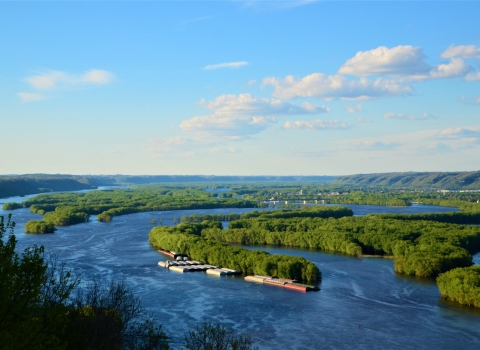The U.S. Fish and Wildlife Service is proposing to designate critical habitat in parts of Tennessee and Virginia for the sickle darter, a species listed as threatened under the Endangered Species Act (ESA) in December 2022. The Service is also announcing the availability of a draft economic analysis of the proposed critical habitat.
“Proposing to designate critical habitat is a step forward in recovery of the sickle darter.” said the Service’s Regional Director, Mike Oetker. “This is a unique species found nowhere else in the world. Proposing critical habitat will help conserve this unique fish”, Oetker added.
The sickle darter is a small, slender-bodied fish typically found in slow flowing pools of larger, upland creeks and small to medium rivers. Historically (prior to 2005), the species was known to occur in nine tributary systems of the upper Tennessee River drainage. Faced with threats primarily from habitat loss and degradation, the species declined, and its range contracted, prompting the Service to propose listing the species as threatened under the ESA.
There are currently only six: the Emory River system (Tennessee), Little River system (Tennessee), Sequatchie River system (Tennessee – discovered in 2014), Upper Clinch River system (Virginia), North Fork Holston River system (Virginia), and Middle Fork Holston River system (Virginia). Populations within the French Broad River (North Carolina and Tennessee), South Fork Holston River (Tennessee), Powell River (Tennessee) and Watauga River systems (Tennessee) have been lost.
When a species is listed under the ESA, the Service is required, where possible, to identify areas essential to the conservation of that species, known as critical habitat. The areas proposed for designation are selected using the best available scientific data. In total, approximately 104 river miles in six units in Bledsoe, Blount, Morgan, and Roane counties, Tennessee, and Scott, Smyth, and Washington counties, Virginia are included in the proposed critical habitat designation. The areas proposed for critical habitat include lands under Federal (1 percent), State (6 percent), and private (93 percent) ownership. There are no lands under Tribal ownership in the proposed designation.
All six units are currently occupied by the sickle darter. Twenty-three listed aquatic species co-occur with the sickle darter in the proposed critical habitat and the proposed units overlap with designated critical habitat for nine of these species: the spotfin chub, yellowfin madtom, Cumberlandian combshell, fluted kidneyshell, oyster mussel, purple bean, rough rabbitsfoot, and slabside pearlymussel. Overlapping critical habitat includes 83 river miles (80 percent) of the proposed critical habitat. Coordinates and plot points for the proposed critical habitat can be downloaded from the Service’s website: https://ecos.fws.gov/ServCat/DownloadFile/219644
Critical habitat designation requires federal agencies to ensure that actions they plan to undertake, fund, or authorize do not destroy or adversely modify that habitat. It does not establish a wildlife refuge, allow the government or public to access private lands, or require non-federal landowners to restore habitat or recover species.
As required by the ESA, the Service assessed the economic impacts of this proposed critical habitat designation. The draft economic analysis found minimal costs associated with this proposed designation, limited to additional administrative costs for considering adverse modification of the sickle darter’s habitat during Section 7 Section 7
Section 7 Consultation
The Endangered Species Act (ESA) directs all Federal agencies to work to conserve endangered and threatened species and to use their authorities to further the purposes of the Act. Section 7 of the Act, called "Interagency Cooperation," is the mechanism by which Federal agencies ensure the actions they take, including those they fund or authorize, do not jeopardize the existence of any listed species.
Learn more about Section 7 consultations.
The Service intends that any final action resulting from this proposed rule will be based on the best scientific data available. Therefore, we request comments or information from other concerned governmental agencies, Native American Tribes, the scientific community, industry, or any other interested parties concerning this proposed rule. Submissions merely stating support for, or opposition to, the action under consideration without providing supporting information, although noted, will not be considered in making a determination.
For directions on how to submit comments, visit the Federal eRulemaking Portal at http://www.regulations.gov. In the Search box, enter FWS-R4-ES-2020-0094, which is the docket number for this rulemaking. Comments must be received by 03/27/2023. We must receive requests for a public hearing, in writing, at the address shown below by 03/27/2023.
For more information on this proposal, please visit our Frequently Asked Questions.
FOR FURTHER INFORMATION CONTACT: Daniel Elbert, Field Supervisor, U.S. Fish and Wildlife Service, Tennessee Ecological Services Field Office, 446 Neal Street, Cookeville, TN 38501-4027; telephone 931-254-9617. Individuals in the United States who are deaf, deafblind, hard of hearing, or have a speech disability may dial 711 (TTY, TDD, or TeleBraille) to access telecommunications relay services. Individuals outside the United States should use the relay services offered within their country to make international calls to the point-of-contact in the United States.
The mission of the U.S. Fish and Wildlife Service is working with others to conserve, protect, and enhance fish, wildlife, plants, and their habitats for the continuing benefit of the American people. For more information on our work and the people who make it happen, visit www.fws.gov. Connect with our Facebook page at www.facebook.com/usfwssoutheast, follow our tweets at www.twitter.com/usfwssoutheast, watch our YouTube channel at http://www.youtube.com/usfws, and download photos from our Flickr page at http://www.flickr.com/photos/usfwssoutheast.




